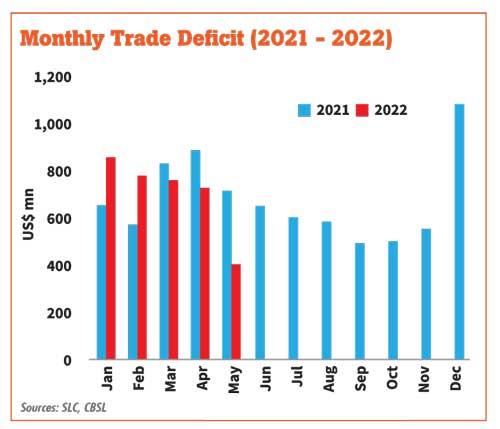Reply To:
Name - Reply Comment
Granting a narrow cumulative trade deficit over the last year for the first time this year, Sri Lanka’s import bill fell to an 18-month low in May amid the forex crisis, rupee depreciation and import control measures.
 Expenditure on merchandise imports declined by 9.7 percent year-on-year (YoY) to US $ 1.45 billion in May, hitting a new low since November 2020. At the same time, merchandise export earnings rose substantially by 17.5 percent YoY to US $ 1.05 billion. As a result, the deficit in the trade account narrowed to US $ 404 million in May for the fifth consecutive month on a month-on-month (MoM) basis and for the third consecutive month on a YoY basis, when compared to the trade deficits of US $ 716 million a year ago and US $ 729 million in the previous month.
Expenditure on merchandise imports declined by 9.7 percent year-on-year (YoY) to US $ 1.45 billion in May, hitting a new low since November 2020. At the same time, merchandise export earnings rose substantially by 17.5 percent YoY to US $ 1.05 billion. As a result, the deficit in the trade account narrowed to US $ 404 million in May for the fifth consecutive month on a month-on-month (MoM) basis and for the third consecutive month on a YoY basis, when compared to the trade deficits of US $ 716 million a year ago and US $ 729 million in the previous month.
“The policy measures to curtail import expenditure such as increase in taxes, restricting imports under several payment terms, imposing licensing and margin requirements as well as forex pressures in the banking system resulted in lower imports,” the Central Bank said.
Due to the sizeable reduction in the trade deficit in the month, the cumulative trade deficit for the five months on a YoY basis narrowed for the first time during this year. The trade deficit for the period narrowed to US $ 3.53 billion, from US $ 3.66 billion, despite an 18.5 percent YoY deterioration in terms of trade i.e., the ratio of the price of exports to the price of imports.
The US $ 336.6 million and US $ 135.7 million increases in textiles and garments and petroleum product export earnings as well as US $ 121 million and US $ 84.3 million declines in telecommunication devices and sugar and confectionery imports were some major contributory factors for the improvement in the cumulative trade deficit.
Expenditure on the consumer goods imports declined by 30.2 percent YoY to US $ 177.1 million, contributed mainly by 11.4 percent and 47.4 percent YoY reductions in food and beverages and non-food consumer goods imports.
The decline in expenditure on food and beverages was mainly due to the import of lower volumes of oils and fats (mainly coconut oil), vegetables (mainly masoor dhal, big onions, chickpeas and garlic), seafood (mainly dried and canned fish), sugar, fruits, spices and dairy products.
However, expenditure on cereals and milling industry products (mainly rice and wheat flour) and beverages in the month remained high. The decline in the imports of non-food consumer goods was driven by telecommunication devices (mainly mobile telephones), home appliances (mainly televisions and fans) and medical and pharmaceuticals (mainly vitamins and vaccines), rubber products (mainly rubber tyres) and household and furniture items.
Despite the low importation of crude oil, the country’s fuel import bill rose by 39.6 percent YoY to US $ 461.4 million in the month, as the average import unit price of refined petroleum increased despite a decline in the volume imported.
The average import price of crude oil stood at US $ 109.94 per barrel in May, compared to US $ 68.47 per barrel year ago. However, the import cost of a range of other intermediate goods, including chemical products, plastics and articles thereof, fertiliser, vehicle and machinery parts, mineral products, etc. showed a decline. The import expenditure on investment goods declined by 22.7 percent YoY to US $ 238.2 million in May.
The decline in the expenditure on machinery and equipment imports was led by reduced import expenditure on telecommunication devices, office machines, machinery and equipment parts and medical and laboratory equipment.
All types of goods listed under building materials declined, with a notable drop in imports of iron and steel, articles of iron and steel and aluminium articles. Further, the import expenditure on transport equipment also contracted, mainly due to the lower imports of tankers and bowsers and agricultural tractors. Meanwhile, industrial export earnings rose by 24.2 percent YoY to US $ 853.2 million in the month, with earnings from textiles and garments rising by a nearly 30 percent YoY to US $ 483.9 million. Further, earnings from petroleum product exports improved by a nearly 60 percent YoY to US $ 53 million, due to the increase in both average export prices and volumes of bunker fuel exports.
However, continuing the lower demand for rubber gloves as a personal protective item, due to the declining spread of COVID-19 worldwide, a decline in earnings was reported in rubber products.
Export earnings from animal fodder and plastics and articles also declined during the month. In contrast, agricultural export earnings declined by 4.2 percent YoY to US $ 190.9 million in the month, with tea exports declining by 14.2 percent YoY to US $ 93.7 million, due to the low volumes. Earning from spices also declined by 16.2 percent YoY to US $ 21.1 million in May, due to lower export volumes except for cinnamon. However, the export of subcategories of minor agricultural products (primarily arecanuts), coconut-related products (primarily fibres and coconut oil), seafood and natural rubber recorded an increase in the month.